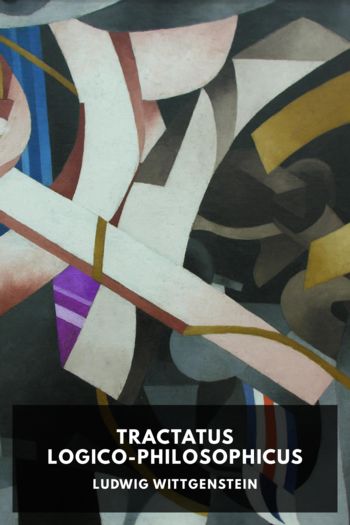Tractatus Logico-Philosophicus - Ludwig Wittgenstein (top 10 ebook reader TXT) 📗

- Author: Ludwig Wittgenstein
Book online «Tractatus Logico-Philosophicus - Ludwig Wittgenstein (top 10 ebook reader TXT) 📗». Author Ludwig Wittgenstein
What I can verify by the experiment is that the occurrence of the two events is independent of the circumstances with which I have no closer acquaintance.
5.155The unit of the probability proposition is: The circumstances—with which I am not further acquainted—give to the occurrence of a definite event such and such a degree of probability.
5.156Probability is a generalization.
It involves a general description of a propositional form.
Only in default of certainty do we need probability. If we are not completely acquainted with a fact, but know something about its form.
(A proposition can, indeed, be an incomplete picture of a certain state of affairs, but it is always a complete picture.)
The probability proposition is, as it were, an extract from other propositions.
5.2The structures of propositions stand to one another in internal relations.
5.21We can bring out these internal relations in our manner of expression, by presenting a proposition as the result of an operation which produces it from other propositions (the bases of the operation).
5.22The operation is the expression of a relation between the structures of its result and its bases.
5.23The operation is that which must happen to a proposition in order to make another out of it.
5.231And that will naturally depend on their formal properties, on the internal similarity of their forms.
5.232The internal relation which orders a series is equivalent to the operation by which one term arises from another.
5.233The first place in which an operation can occur is where a proposition arises from another in a logically significant way; i.e. where the logical construction of the proposition begins.
5.234The truth-functions of elementary proposition, are results of operations which have the elementary propositions as bases. (I call these operations, truth-operations.)
5.2341The sense of a truth-function of p is a function of the sense of p.
Denial, logical addition, logical multiplication, etc., etc., are operations.
(Denial reverses the sense of a proposition.)
5.24An operation shows itself in a variable; it shows how we can proceed from one form of proposition to another.
It gives expression to the difference between the forms.
(And that which is common to the bases, and the result of an operation, is the bases themselves.)
5.241The operation does not characterize a form but only the difference between forms.
5.242The same operation which makes “q” from “p”, makes “r” from “q”, and so on. This can only be expressed by the fact that “p”, “q”, “r”, etc., are variables which give general expression to certain formal relations.
5.25The occurrence of an operation does not characterize the sense of a proposition.
For an operation does not assert anything; only its result does, and this depends on the bases of the operation.
(Operation and function must not be confused with one another.)
5.251A function cannot be its own argument, but the result of an operation can be its own basis.
5.252Only in this way is the progress from term to term in a formal series possible (from type to type in the hierarchy of Russell and Whitehead). (Russell and Whitehead have not admitted the possibility of this progress but have made use of it all the same.)
5.2521The repeated application of an operation to its own result I call its successive application (“O′O′O′a” is the result of the threefold successive application of “O′ξ” to “a”).
In a similar sense I speak of the successive application of several operations to a number of propositions.
5.2522The general term of the formal series a, O′a, O′O′a, … I write thus: “[a,x,O′x]”. This expression in brackets is a variable. The first term of the expression is the beginning of the formal series, the second the form of an arbitrary term x of the series, and the third the form of that term of the series which immediately follows x.
5.2523The concept of the successive application of an operation is equivalent to the concept “and so on.”
5.253One operation can reverse the effect of another. Operations can cancel one another.
5.254Operations can vanish (e.g. denial in “~~p”. ~~p=p).
5.3All propositions are results of truth-operations on the elementary propositions.
The truth-operation is the way in which a truth-function arises from elementary propositions.
According to the nature of truth-operations, in the same way as out of elementary propositions arise their truth-functions, from truth-functions arises a new one. Every truth-operation creates from truth-functions of elementary propositions, another truth-function of elementary propositions i.e. a proposition. The result of every truth-operation on the results of truth-operations on elementary propositions is also the result of one truth-operation on elementary propositions.
Every proposition is the result of truth-operations on elementary propositions.
5.31The schemata No. 4.31 are also significant, if “p”, “q”, “r”, etc. are not elementary propositions.
And it is easy to see that the propositional sign in No. 4.442 expresses one truth-function of elementary propositions even when “p” and “q” are truth-functions of elementary propositions.
5.32All truth-functions are results of the successive application of a finite number of truth-operations to elementary propositions.
5.4Here it becomes clear that there are no such things as “logical objects” or “logical constants” (in the sense of Frege and Russell).
5.41For all those results of truth-operations on truth-functions are identical, which are one and the same truth-function of elementary propositions.
5.42That ∨, ⊃, etc., are not relations in the sense of right and left, etc., is obvious.
The possibility of crosswise definition of the logical “primitive signs” of Frege





Comments (0)